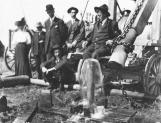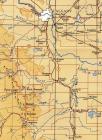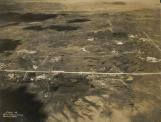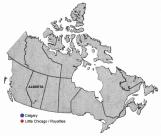1
The Turner Valley Oil Boom!Oil (and wet gas) was discovered at the Dingman No. 1 well near Turner Valley, Alberta in May 1914. W.S. Heron, a miner from Ontario noticed an oil seepage on a farm near Turner Valley. He bought the farm, acquired the mineral rites, and formed a company called Calgary Petroleum Products Company. They started drilling and struck "wet gas" and oil. The news hit nearby Calgary like a bombshell, and with a day, promoters formed more than 500 companies!
Until oil was discovered at Leduc in 1947, the Turner Valley oilfields played a major part in the Alberta oil and gas industry. Not only did the oilfields produce oil and gas, they also produced highly trained people that would go on to work at oilfields in Alberta and around the world. Unfortunately there was more "wet gas" than oil in the wells, and relatively small volumes of oil actually came from the wells in this area.
2
Five men and one woman watch water spilling from a well case in the front of a drilling rig1914
Southwestern Alberta, Canada
 Credits:
Credits:Museum of the Highwood, 983.034.023
3
New Era Evolves! Dingman Discovery Well Cause for Great Jubilation!"Following weeks of high hopes and speculation, there was great cause for jubilation last Thursday, May 14th when a large flow of oil was struck in the Black Diamond field. The Discovery well is situated in the heart of Turner Valley, in the proximity of the post office at Black Diamond. A.W. Dingman is manager and chief driller for the discoverers, Calgary Petroleum Products.
The jubilation of the people living in the locality, who will receive the greatest benefit from the find, is shared by all in the southern part of the province. The value of the find will be incalculable to the entire district. There is almost bound to be an upward tendency in land value over an area stretching from Calgary to Lethbridge.
The amount of good business that will be generated throughout southern Alberta, as a result of the discovery, is almost too much to imagine. Heretofore, some hesitancy has been shown by investors to view the oil fields as a likely proposition, as so many of them have been bitten by previous oil propositions.
The discovery of oil will put an end to that hesitancy. The Black Diamond oil fields will bring thousands of dollars to be invested, which will mean great enrichment for the south part of the province."
- High River Times, May 14, 1914
5
Map of the Turner Valley OilfieldsCirca 1940
Southwestern Alberta, Canada
 Credits:
Credits:Museum of the Highwood
6
Aerial photo of the Turner Valley OilfieldsCirca 1942
Turner Valley, Alberta, Canada
 Credits:
Credits:Museum of the Highwood
7
Turner Valley oilfieldsCirca 1938
Turner Valley, Alberta, Canada
 Credits:
Credits:Museum of the Highwood, 989.002.262
8
Unidentified wooden oil derrick and shedsCirca 1938
Turner Valley oilfields, Alberta, Canada
 Credits:
Credits:Museum of the Highwood, 989.002.260
10
Gas flare burning in the Turner Valley OilfieldsCirca 1938
Turner Valley, Alberta, Canada
 Credits:
Credits:Museum of the Highwood, 989.002.254
11
Hell's Half AcreThere was a huge amount of natural gas wasted in the Turner Valley oilfields. The problem occurred due to the common practice of passing the gas through separators and then flaring it off. The producers flared the by-product gas after producing the oil. The value was in the oil - not the natural gas. The lights from the flares were seen from miles away. It was said that aviators from as far away as Regina could see the glow in the sky from the flares! One of the biggest and brightest lights shone from a ravine known as Hell's Half Acre that roared away for years just northeast of the town of Turner Valley.
12
Hell's Half Acre, Turner ValleyCirca 1924
Turner Valley, Alberta, Canada
 Credits:
Credits:Museum of the Highwood, 977.065.075
13
Hell's Half Acre, Turner ValleyJuly 1926
Turner Valley, Alberta, Canada
 Credits:
Credits:Museum of the Highwood
14
Many communities sprang up throughout the South Turner Valley oilfields including: Whiskey Road, Poverty Flats, Dogtown, Snob Hill, Cuffling Flats, Naptha, Mercury Camp, Hartell, Little New York, Little Philadelphia and Little Chicago.Little New York (later Longview) was located just three kilometers south of Little Chicago. It was also a bustling little town. Unlike Little Chicago, Longview survived.

